As an Amazon Associate KitchenwareSets.com earns from qualifying purchases.
7 Clever Kitchen Drawer Organization Ideas to Maximize Space
Are you tired of playing Tetris with your spatulas every time you open a drawer? Does the clatter of a dozen utensils greet you every morning as you search for a single teaspoon? If you’ve ever found yourself wrestling with a jumbled mess of whisks, rolling pins, and mysterious gadgets, you know the frustration of a disorganized kitchen. That one “junk drawer” that started as a catch-all has likely multiplied, turning prime kitchen real estate into a chaotic black hole.
This kitchen clutter isn’t just an eyesore; it’s a constant, low-level stressor that chips away at the joy of cooking. It makes finding what you need a frustrating treasure hunt, slows down your meal prep, and turns a space that should be the heart of your home into a source of inefficiency. I’ve been there—staring into a drawer that looked like a cutlery explosion and feeling completely overwhelmed.
The journey from chaos to calm is simpler than you think. The first step to organizing kitchen drawers is to completely empty, declutter, and categorize everything. By grouping similar items like cooking utensils, flatware, and spices together, you create a foundation for order. This foundational step makes it easier to assign a permanent, sensible home for every single item, transforming your kitchen’s functionality and your daily routine.
Are Your Kitchen Drawers a Chaotic Mess? Here’s How to Reclaim Your Space
The first step to organizing kitchen drawers is to completely empty, declutter, and categorize everything. This is the non-negotiable starting point. You can’t organize clutter. Pull every single item out of your drawers and lay it on your countertop. This visual inventory is often shocking but incredibly motivating. It’s the moment you realize you own six can openers but can never find one when you need it.
Once everything is out, it’s time to be ruthless. Create three piles: Keep, Relocate, and Discard/Donate.
* Keep: These are the items you use regularly and that belong in the kitchen.
* Relocate: The stray batteries, pens, and rubber bands that migrated into the kitchen can be moved to a more appropriate home.
* Discard/Donate: Be honest about what you use. That avocado slicer you got as a gift three years ago? The duplicate set of measuring spoons? Let them go.
After purging, group your “Keep” items into logical categories: everyday silverware, cooking utensils, baking tools, knives, spices, dish towels, and so on. This simple act transforms a mountain of chaos into manageable molehills. From my own experience, I know this initial purge feels like the biggest hurdle, but it’s also the most rewarding. It clears the slate and allows you to rebuild your kitchen’s functionality from the ground up, creating a streamlined space that works for you, not against you.
7 Clever Kitchen Drawer Organization Ideas to Maximize Space (Updated for 2025)
With your drawers empty and your items categorized, you’re ready for the fun part: implementing clever organization solutions that maximize every square inch. There is a perfect solution for every type of drawer, whether it’s a shallow space for cutlery or a deep cavern for pots and pans. This list combines elegant, easy-to-buy solutions with practical, DIY-friendly concepts to help you create a kitchen that is as functional as it is beautiful.
- Utilize Expandable Utensil Trays
- Install an In-Drawer Knife Block
- Organize with a Tiered Spice Rack Insert
- Create Custom Zones with Adjustable Dividers
- Tame Deep Drawers for Pots and Pans
- Go Vertical with Linens and Wraps
- Designate a Kid-Friendly Station
1. The Ultimate Utensil Upgrade: Expandable Trays for a Perfect Fit
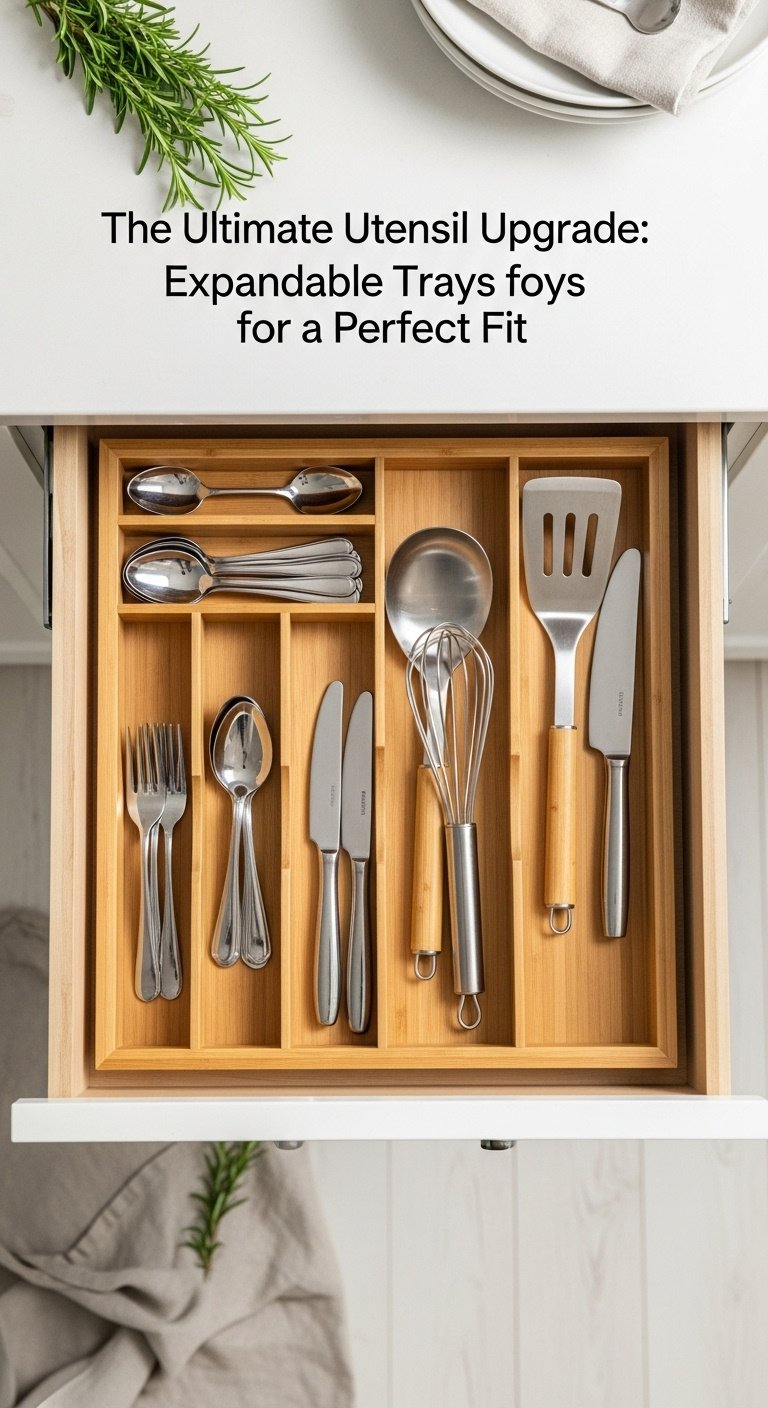
The best way to organize both flatware and large utensils in one place is by using an expandable utensil tray that adjusts to the exact width of your drawer. Standard, one-size-fits-all trays often leave awkward gaps on the sides where small items get lost, or they simply don’t fit. An expandable organizer eliminates wasted space and creates a custom, built-in look.
Save this to your ‘Dream Kitchen’ board for instant inspiration!
These versatile trays, often made from beautiful bamboo or easy-to-clean plastic, feature a main section for forks, knives, and spoons, and one or two sliding sections that pull out to perfectly fit your drawer’s width. These expanded compartments are ideal for corralling larger, irregularly shaped tools like spatulas, whisks, and tongs that never seem to fit anywhere else.
- Materials Needed: Tape measure, expandable utensil tray (bamboo or plastic), non-slip drawer liner (optional).
- Step-by-Step Directions:
- Measure: Measure the interior width and depth of your drawer.
- Select: Purchase an expandable tray that can contract to a size smaller than your drawer and expand to a size slightly larger for a snug fit.
- Install: Place the tray in the drawer. Slide the expandable section outwards until it fits securely against the drawer walls.
- Organize: Arrange your flatware in the main compartments and your larger cooking utensils in the newly created side compartments.
Pro-Tip: Look for trays with diagonal compartments for longer knives or serving spoons. A thin layer of non-slip liner underneath the tray can prevent any shifting, even in heavily used drawers.
2. The Counter Space Saver: In-Drawer Knife Blocks
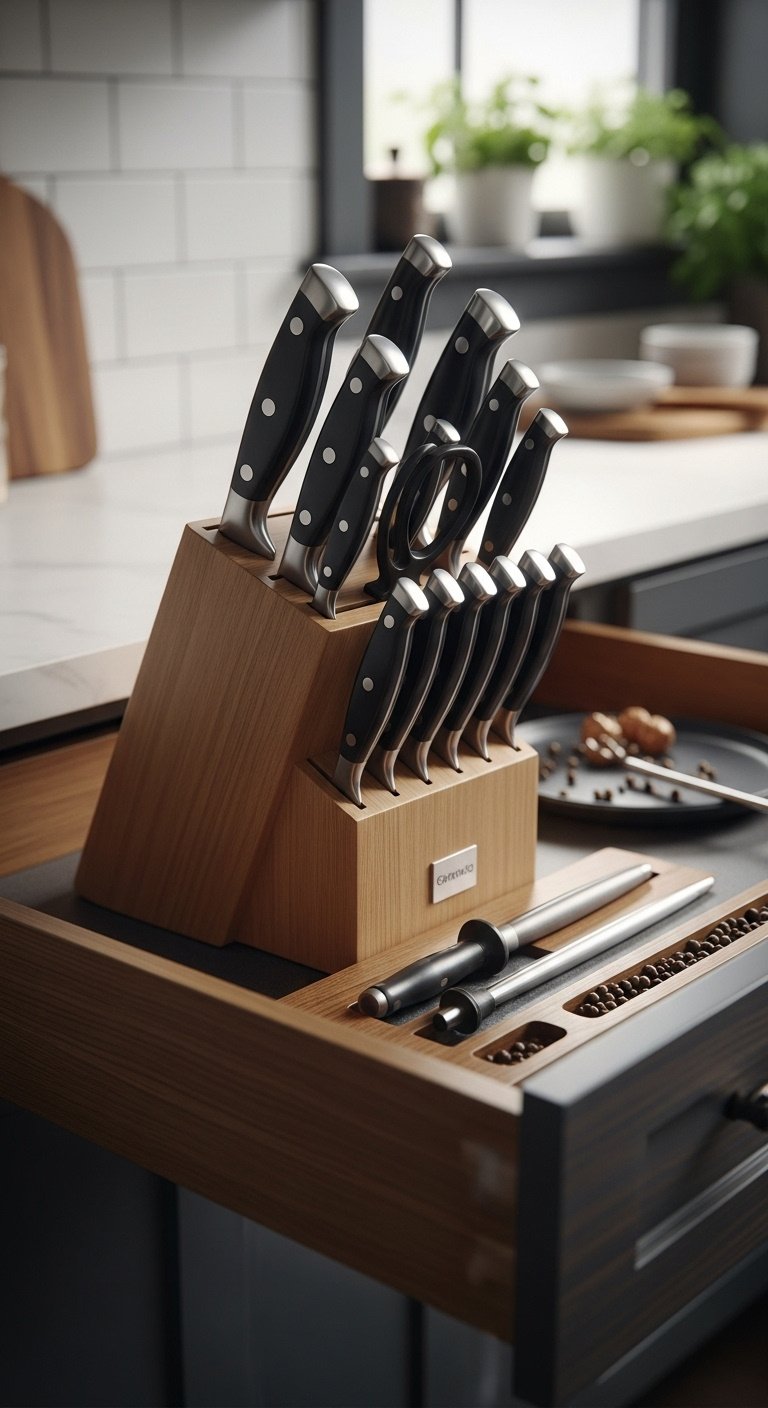
To save counter space and safely store knives, use a dedicated in-drawer knife block insert that nests your blades securely. Bulky countertop knife blocks eat up valuable prep space and can be an eyesore. Storing sharp knives loosely in a drawer is a safety hazard and dulls the blades quickly. An in-drawer block is the perfect solution.
Pin this clever idea to free up your countertops!
These inserts are designed to lay flat or at a slight angle in your drawer, with slots that hold your knives securely. The blades are protected, and the handles are aligned for easy identification and access. It’s a sleek, safe, and efficient way to store your entire knife collection while reclaiming your countertops for what they do best: food prep.
- Materials Needed: Tape measure, in-drawer knife block insert.
- Step-by-Step Directions:
- Measure Drawer: Carefully measure the width, length, and height of your drawer to ensure the knife handles will not obstruct it from closing.
- Count Knives: Take inventory of your knives to choose an insert with enough slots for your collection.
- Place Insert: Simply place the knife block into the drawer. Most are designed with a low profile to fit standard kitchen drawers.
- Store Safely: Arrange your knives in the slots with the blades pointing down and away for safety.
Lesson Learned: Double-check the maximum blade length the organizer can accommodate. Some blocks are not designed for extra-long bread knives or cleavers.
3. The Spice Seeker’s Solution: Tiered Drawer Inserts
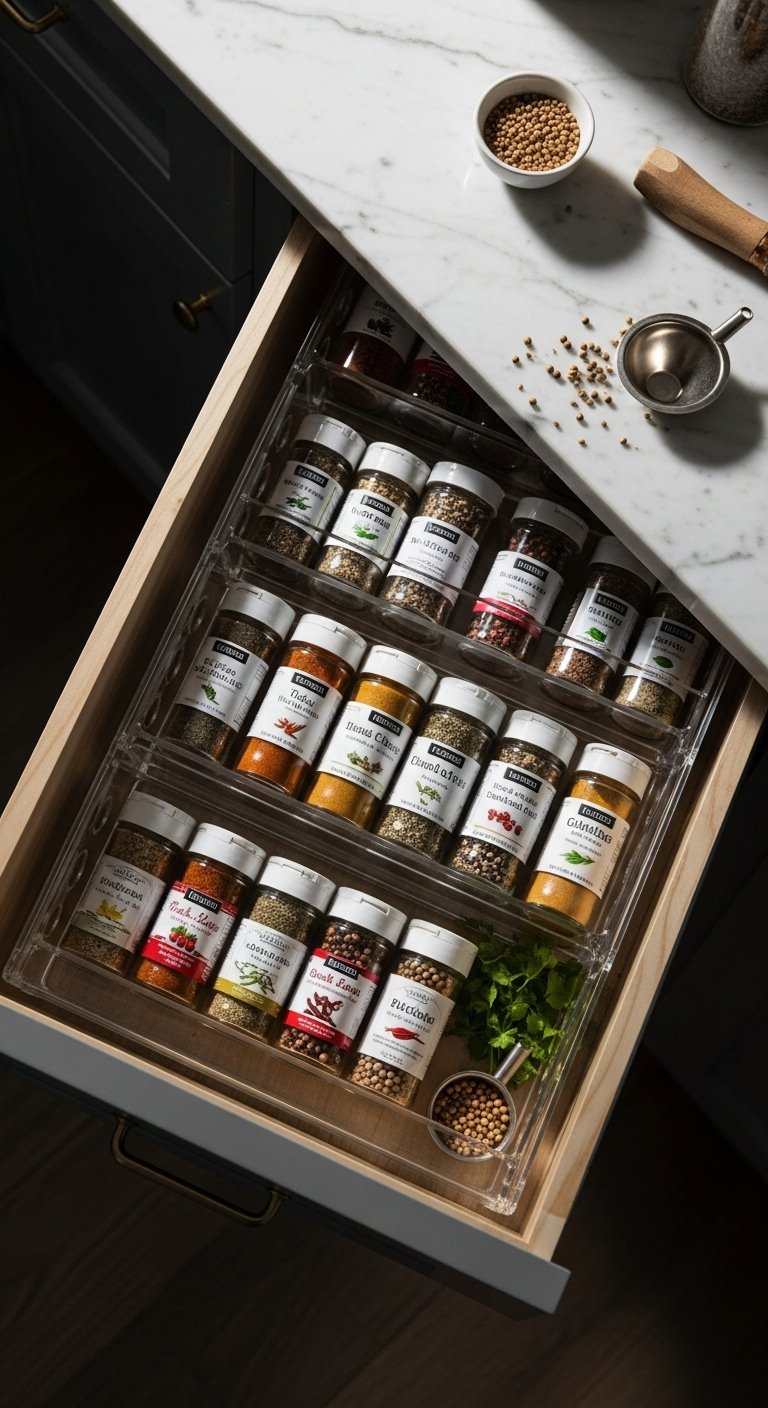
The most effective way to organize spices in a drawer is with a tiered or angled spice rack insert, which displays every jar so labels are clearly visible. Stop digging through a jumble of rolling, identical-looking jars. Transforming a shallow drawer near your stove into a “spice library” is a game-changer for any home cook.
Love this idea? Share it on your ‘Kitchen Organization’ board!
These inserts, often made of clear acrylic, plastic, or wood, create slanted levels that hold your spice jars at an angle. When you pull open the drawer, you can instantly see every single label without having to pick up a single jar. It turns seasoning your food from a frantic search into a simple, pleasing action. For a truly professional look, decant your spices into uniform jars with matching labels.
- Materials Needed: Tape measure, tiered spice drawer insert/liner, uniform spice jars (optional), label maker (optional).
- Step-by-Step Directions:
- Measure: Measure the interior width and length of the drawer you’ve designated for spices.
- Choose Your Insert: Select an expandable insert or a cut-to-fit liner that matches your drawer’s dimensions.
- Decant & Label (Optional): For a truly uniform look, transfer spices into matching jars and create clear, easy-to-read labels.
- Arrange: Place the insert in the drawer and arrange your spice jars alphabetically or by frequency of use. The tiered design will keep them all visible.
Pro-Tip: Before you buy an insert, lay your tallest spice jar in the drawer and close it to ensure there’s enough clearance.
4. The “Junk Drawer” Tamer: Versatile Adjustable Dividers
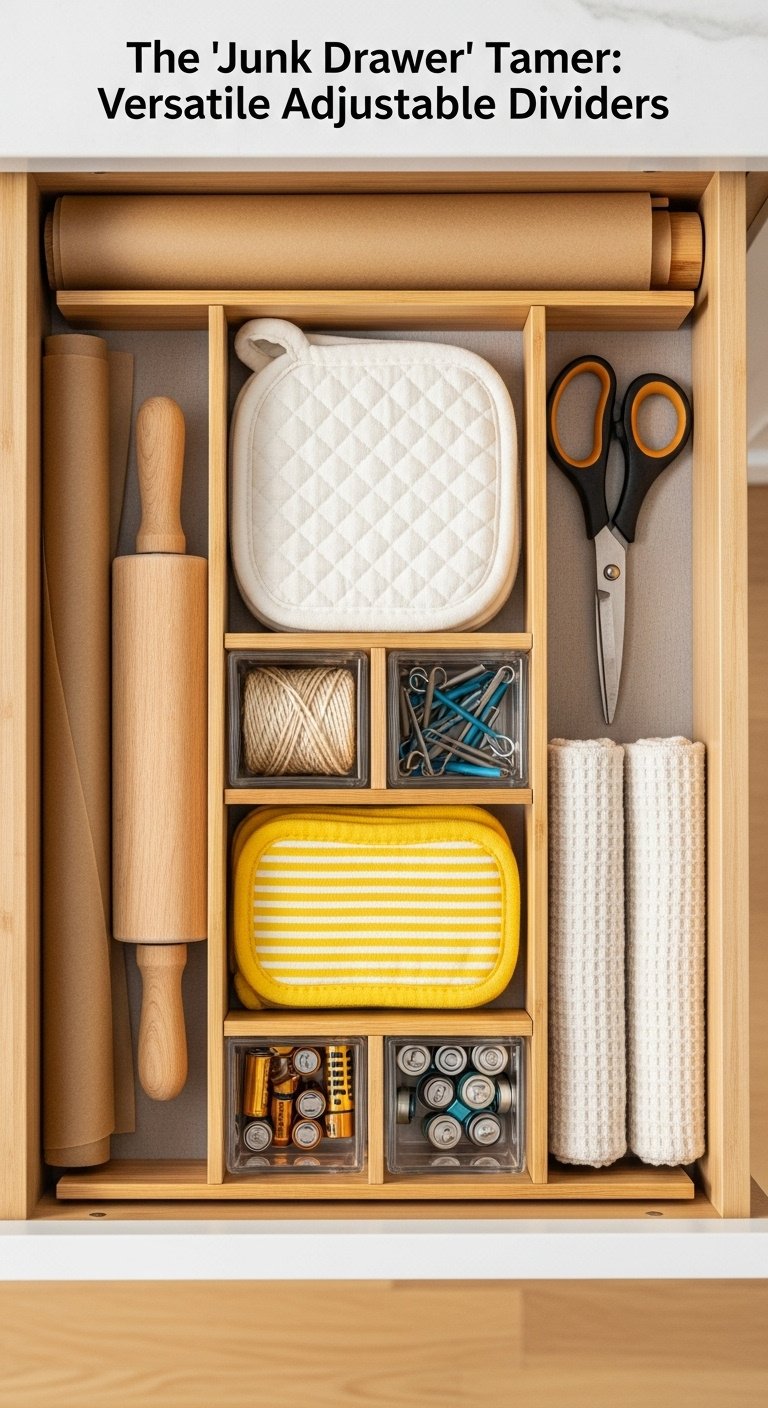
To finally conquer a “junk drawer” with its mix of odd-shaped items, use versatile, spring-loaded adjustable dividers to create custom-sized compartments. Every kitchen has that one drawer filled with a random assortment of necessities: scissors, a rolling pin, chip clips, twine, batteries. A standard tray organizer just won’t work.
Know someone who needs this? Share this junk drawer solution!
Adjustable dividers are the ultimate tool for creating order out of chaos. These dividers, typically made of bamboo or plastic, use tension or a spring-loaded mechanism to fit snugly within your drawer. You can place them lengthwise or widthwise to create perfect-sized homes for all your miscellaneous tools. This approach allows you to “give every item a home,” turning the junk drawer into a highly functional utility drawer.
- Materials Needed: Tape measure, spring-loaded or tension-based adjustable dividers.
- Step-by-Step Directions:
- Declutter: Sort through the drawer, discarding trash and relocating items that don’t belong.
- Group: Group the remaining items by category or size.
- Install Dividers: Insert the first divider by compressing the spring, placing it in the drawer, and letting it expand to create a snug fit.
- Create Zones: Add more dividers, running them lengthwise or widthwise, to create custom-sized compartments for each group of items.
Pro-Tip: Use small, clear boxes or cubbies within the larger divided sections to further contain tiny items like rubber bands, twist ties, or batteries.
5. The Deep Drawer Dynamo: Organizing Pots, Pans, and Lids
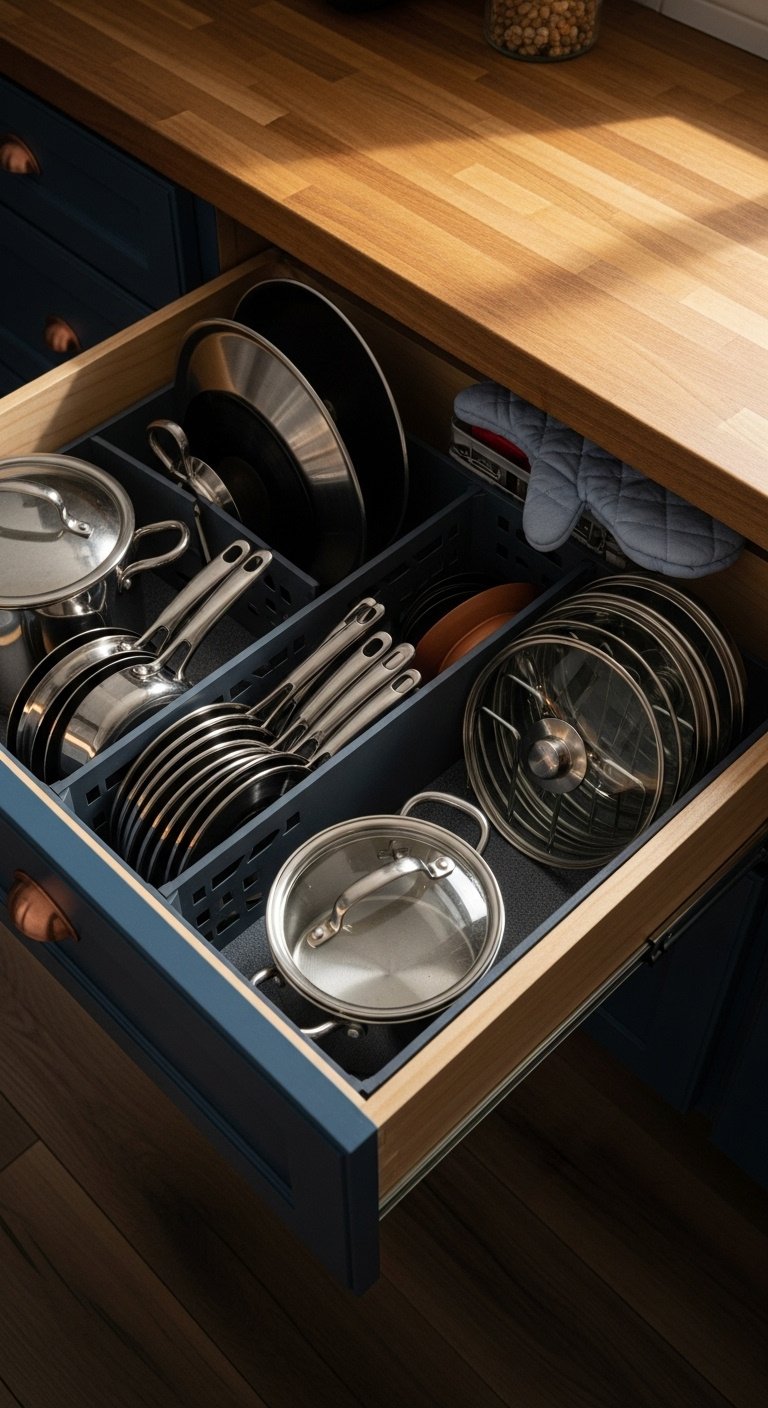
The best method for organizing deep drawers is to file pots and pans vertically using heavy-duty dividers, which prevents stacking and scratching. Deep drawers are a fantastic alternative to low cabinets, but they can quickly become a noisy, jumbled pile of cookware if not organized properly. The sound of clanging pans and the hassle of unstacking five pans to get to the one at the bottom is a common kitchen headache.
Pin this pot & pan solution for your future kitchen!
By using sturdy, adjustable dividers designed for deep drawers, you can create channels to store your pots, pans, and even baking sheets on their side, like files in a cabinet. This not only protects your cookware from getting scratched but makes it incredibly easy to see and grab exactly what you need. For the perpetually problematic lids, use a separate lid organizer rack or another divider to file them vertically by size.
- Materials Needed: Heavy-duty deep drawer dividers or a dedicated pot and pan organizer rack.
- Step-by-Step Directions:
- Assess Your Cookware: Determine which pans you use most frequently; they should be the most accessible.
- Install Dividers: Place heavy-duty adjustable dividers in the drawer, creating channels wide enough to hold your pans on their side.
- File, Don’t Stack: Slide your pots and pans into the channels vertically.
- Contain Lids: Use a separate tension rod or a dedicated lid organizer rack to file lids vertically, making it easy to grab the right one.
Lesson Learned: Filing pans vertically not only prevents scratches on non-stick surfaces but also makes it incredibly easy to grab the exact one you need without unstacking the entire pile.
6. The Space-Saving Roll: Vertical Storage for Towels and Wraps

A clever space-saving tips for towels and wraps is to roll towels and store them vertically, and use a dedicated organizer for foil and plastic wrap boxes. Drawers designated for linens and food wraps often become messy, with towels unfolding and cardboard boxes getting crushed. A simple change in storage orientation can make a world of difference.
A simple tips for a tidy drawer! Save this idea now!
Instead of folding and stacking your kitchen towels, roll them tightly and stand them up in the drawer like little logs. You’ll be amazed at how many more you can fit and how easy it is to see all your options at once. For your food wraps, invest in a simple bamboo or plastic organizer that holds the rolls, allowing you to dispense foil or wrap without wrestling with the flimsy original box.
- Materials Needed: Drawer dividers (optional), food wrap box organizer.
- Step-by-Step Directions:
- For Towels: Fold each towel in half lengthwise, then in half again. From the non-folded edge, roll it up tightly. Place the rolled towels upright in the drawer.
- For Wraps: Purchase a dedicated organizer that can hold multiple boxes. Remove the wraps from their flimsy cardboard packaging and place the rolls into the organizer for a streamlined look and easy dispensing.
- Separate: Use a simple drawer divider to create a dedicated zone for your rolled towels and another for your wrap organizer.
Pro-Tip: Rolling towels not only saves space but also prevents the entire stack from being disturbed when you pull one out from the bottom.
7. The Little Helper Hub: A Low-Level Kids’ Drawer
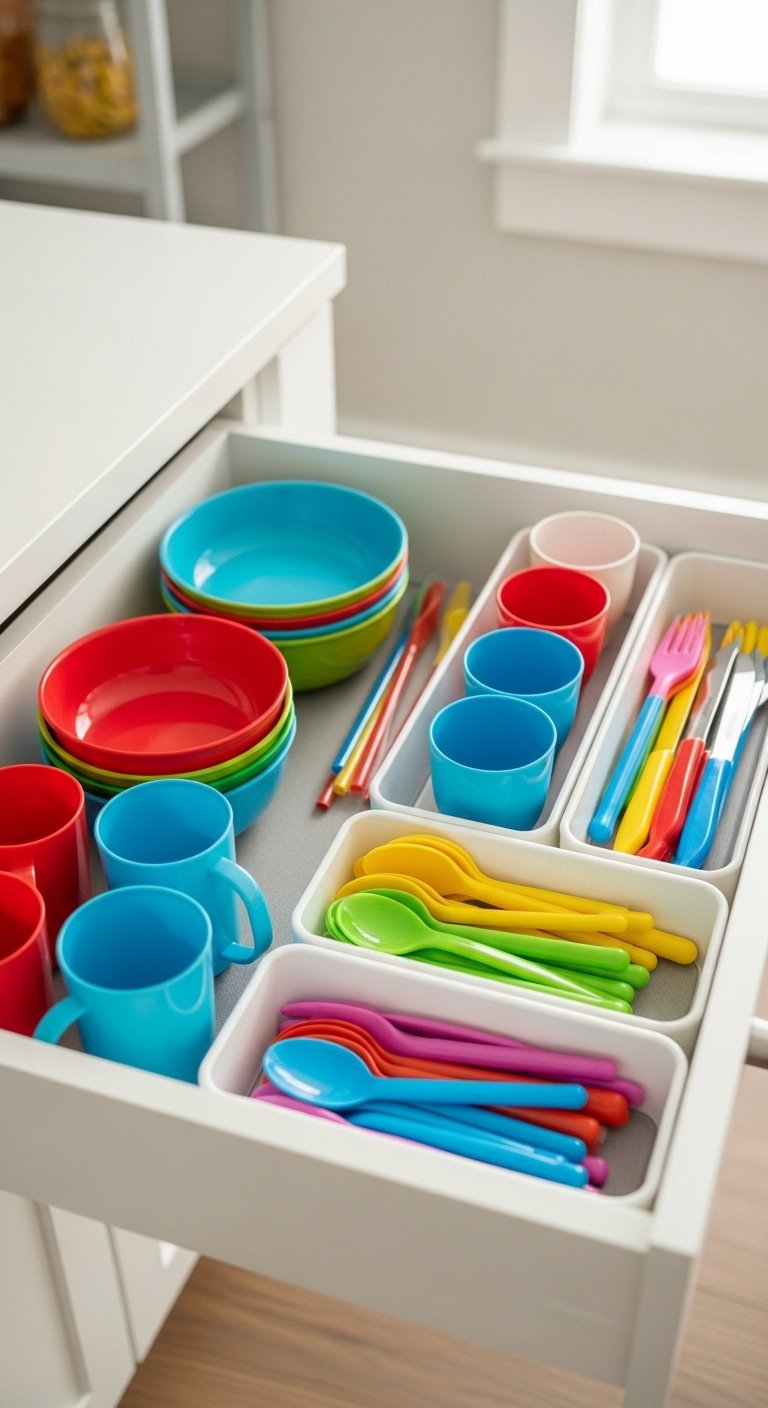
To foster independence and keep kids’ items separate, create a dedicated, low-level drawer with simple dividers for their plastic plates, cups, and utensils. If you have children, you know how their brightly colored dishware can take over a cabinet. By creating an accessible “kid zone,” you not only organize their items but also empower them to help themselves and participate in kitchen routines.
A great tip for parents! Pin this for your family kitchen.
Choose a low drawer that your child can safely reach and outfit it with simple, easy-to-clean plastic dividers or small bins. Designate spots for their plates, bowls, cups, and silverware. This system makes it easy for them to grab their own snack bowl or set their place at the table. It’s a brilliant way to promote self-sufficiency and keep your main dish drawers reserved for your own items.
- Materials Needed: Non-slip drawer liner, simple plastic drawer dividers or small bins.
- Step-by-Step Directions:
- Choose a Low Drawer: Select a drawer that your child can safely and easily reach.
- Line the Drawer: Install a non-slip liner to prevent items from sliding around.
- Install Dividers: Use simple, easy-to-clean plastic dividers or small bins to create separate zones for plates, bowls, cups, and utensils.
- Stock It Up: Fill the drawer with your child’s non-breakable kitchenware. Show them where everything goes to encourage them to help unload the dishwasher.
Lesson Learned: This simple system not only keeps kids’ items out of your main dish drawers but also fosters independence and responsibility from a young age.
Key Takeaways: Your Quick Guide to Kitchen Drawer Organization
Feeling inspired? Here’s a quick summary of the core principles to remember as you tackle your own kitchen drawer organization project.
- Declutter First: Always begin by emptying and sorting your drawers. You can’t organize clutter.
- Use Dividers: Expandable trays and adjustable dividers are the most powerful tools for creating order.
- Think Vertically: Store items like pans, lids, and towels on their sides to maximize space and improve accessibility.
- Assign a Home: Every item, from spices to spatulas, needs a designated spot.
- Maintain Regularly: Spend five minutes each month tidying your drawers to prevent chaos from returning.
https://www.youtube.com/watch?v=tOJj82Bfk3g
People Also Ask About Kitchen Drawer Organization
What is the best way to organize kitchen drawers?
The best way to organize kitchen drawers is to first declutter, then categorize similar items together. Use drawer organizers like expandable utensil trays for cutlery, in-drawer blocks for knives, and tiered inserts for spices. For deep drawers or mixed items, adjustable dividers are key to creating custom compartments and maximizing space.
What are some alternatives to drawer dividers?
Great alternatives to drawer dividers include small, clear storage cubbies or boxes to contain loose items. For a DIY approach, you can use sturdy cardboard, thin plywood, or even repurposed food boxes cut to size. Tension rods can also work well in deep drawers to separate items like baking sheets or lids.
Does Ikea have drawer dividers?
Yes, IKEA offers a wide range of kitchen drawer organization solutions. Their UPPDATERA and MAXIMERA series include various options like cutlery trays, utensil trays, plate holders, and adjustable drawer dividers designed to fit perfectly within their kitchen cabinet systems, but they can often be adapted for other drawers as well.
Final Thoughts
Transforming your kitchen drawers from chaotic to calm is a weekend project that pays off every single day. It’s about more than just tidiness; it’s about creating a more efficient, enjoyable, and peaceful environment for yourself and your family. With a clear plan and the right tools, you can create a kitchen that truly works for you.
What’s the one drawer in your kitchen that needs the most help right now? Share in the comments below
